Have you ever wondered what are seventh chords? If so, you’re in the right place, Skoove is here to help. 7th chords are commonly found in all music. Genres like jazz and blues are synonymous with the sound of seventh chords. These interesting piano chords add a bit more flavour than standard chords and are amazing tools for composers and performers to add to their palette. In this article we will break down what seventh chords are, how to build them and most importantly, how to play them. Let’s get started!

What are 7th chords in music?
A seventh chord is made from a root, third, fifth and a seventh. These chords are commonly used to introduce a wider spectrum of tension and resolution, giving music more harmonic possibilities and character. They give a player or composer a much broader variety of sounds and feelings than standard three note chords. In this article we will use both piano intervals and scale degrees to break down these chords step by step to help you understand how they work as well as how to find and build them.
Types of seventh chord
The types of 7th chord can be notated using a combination of letters, numbers or symbols to indicate their quality and structure. This is done above the written version on the staff or through the use of chord charts.
For example:
- C major seventh – Cmaj7,C^
- C minor seventh – Cm7
- C minor major seventh – Cmin(maj7) or Cm^
- C dominant seventh – C7.
- C half-diminished – can be either Cø7 or Cm7♭5.
- C fully diminished seventh – C°7.
- C augmented major seventh – C^#5 or C^+
- C augmented dominant seventh – C7#5 or C7+
- C altered seventh – C7alt

Although it is not as common in modern notation, Roman numeral analysis can also be used to notate 7th chords. Major seventh chords are written as I⁷ (e.g. Cmaj7 in C major), dominant sevenths as V⁷ (e.g G7 in C major) and minor sevenths as ii⁷ (e.g. Dm7 in C major). This highlights the context of the chord as well as its quality.
Both these ways of writing chord symbols can help musicians quickly understand harmonic functions and chord relationships in music. In this article we will focus on letter notation rather than roman numerals. Let’s examine the wide variety of 7th chords on offer, how they sound and how to use them.
Major 7th chord (maj7)
A major seventh chord has a bright major sound. It is formed from the first degree of the major scale. It’s often used for resolutions that require a little more interest than a simple major chord. It can often be found being used in jazz and pop adding a bit of sophistication. The major seventh chord is characterized by major seventh giving it its characteristic rich sound with brightness and a hint of longing. Try playing this example of a Cmaj7.
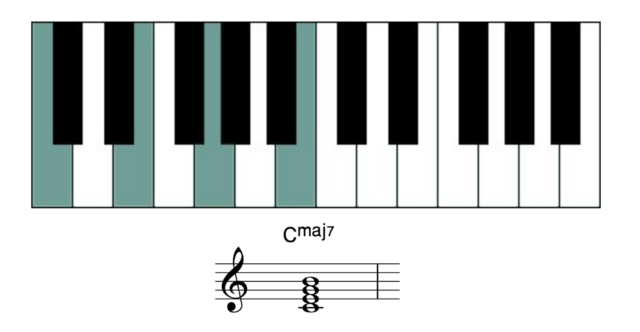
Stacked:
B – major third
G – minor third
E – major third
C – Root
From the root:
B – major seventh
G – perfect fifth
E – major third
C – Root
This chord can be constructed by stacking thirds from the first note of a major scale. Notice how these notes are the first, third, fifth and seventh of C major. This construction based on the root note of a major scale allows this chord to be used as a tonic resolution with the major seventh interval adding a feeling of longing.
Minor 7th chord (m7)
A minor seventh chord has a smooth minor sound. It is often used in minor resolutions when a bit more interest is required than a simple minor triad. It can also be found being used in jazz and pop to add a bit of a richer feel.
The minor seventh chord is characterized by a minor seventh interval. This addition to a minor triad gives it a smooth and melancholic quality. Try playing this example of a Cm7.
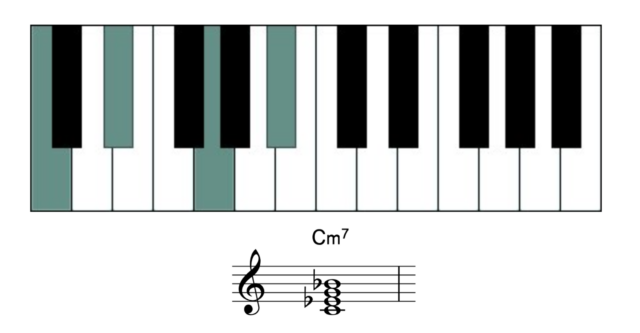
Stacked:
Bb – minor third
G – major third
Eb – minor third
C – Root
From the root:
Bb – minor seventh
G – perfect fifth
Eb – minor third
C – Root
A minor 7th chord can be constructed by stacking thirds from the first note of a minor scale. Notice how these notes are the first, third, fifth and seventh of C minor. This construction from the root of a minor scale is what allows it to be used as a minor resolution with extra flavour.
Minor major 7th chord (min maj7)
A minor major seventh chord has a very striking mysterious minor sound. It is often used in minor progression to add some surprise and tension. It can often be found in scores where it gives a feeling of unease and mystery.
The minor major seventh chord is a unique blend of minor and major tonality. It’s a minor chord with an added seventh interval. This addition creates a mysterious and dramatic sound. Have a go at playing this example of a CmMaj7.
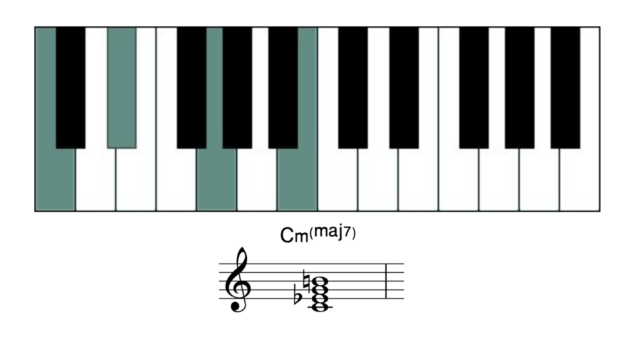 Stacked:
Stacked:
B – major third
G – major third
Eb – minor third
C – Root
From the root:
B – major seventh
G – perfect fifth
Eb – minor third
C – Root
The minor major 7th chord can be formed from the first degree of the harmonic minor scale. The raised 7th of a harmonic minor is what gives this chord its unique sound.
Dominant 7th chord (7)
A dominant seventh chord has a tense but major sound. It can often be found being used in jazz and pop to add build up tension before a resolution in both major and minor keys.
The dominant seventh chord is characterized by its strong, bluesy sound, created by the lowered seventh interval. Try playing this example of a C7 piano chord.
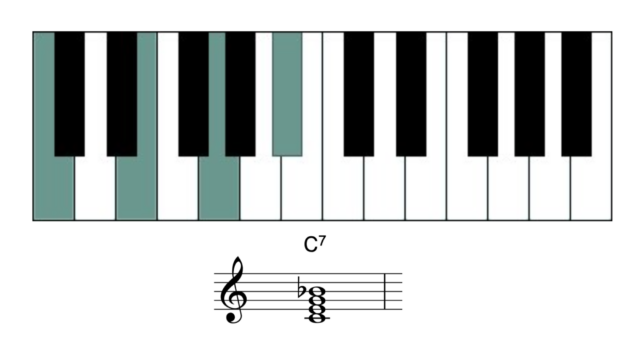
Stacked:
Bb – minor third
G – minor third
E – major third
C – Root
From the root:
Bb – minor seventh
G – perfect fifth
E – major third
C – Root
A dominant 7th chord formed by stacking thirds from the fifth degree of the major scale. The minor 7th of a C7 chord is created by building this chord on a 5th degree of a scale. This is what gives this chord its need for resolution. It can often be found as a chord just before a major or minor resolution to a tonic chord.
Half-diminished 7th chord (m7♭5)
The half-diminished seventh chord has a dark and unstable sound, often used in minor key progressions. It is commonly used in jazz and before a dominant seventh for a more unstable, tense sound which sets up resolutions well.
The half diminished 7th chord is characterized by a tense minor sound, created by the diminished fifth interval. Try playing this example of a Cø7.
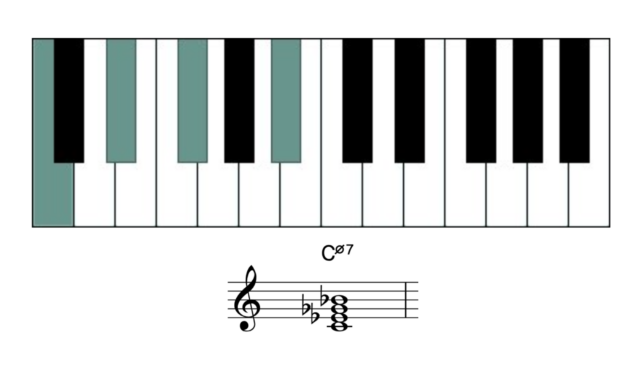
Stacked:
Bb – major third
Gb – minor third
Eb – minor third
C – Root
From the root:
Bb – minor seventh
Gb – diminished fifth
Eb – minor third
C – Root
The half diminished 7th chord can be formed by stacking thirds from the second degree of a minor scale.
Diminished 7th chord (dim7)
The diminished seventh chord has a crunchy sound, often used to create interesting harmonic transitions and voice leading in progressions and modulations. It is used in jazz and classical music and for a more unstable, tense sound before a resolution.
The diminished seventh chord has a highly tense and dramatic sound due to its diminished 5th and 7th degrees. Try playing this example of a C°7.
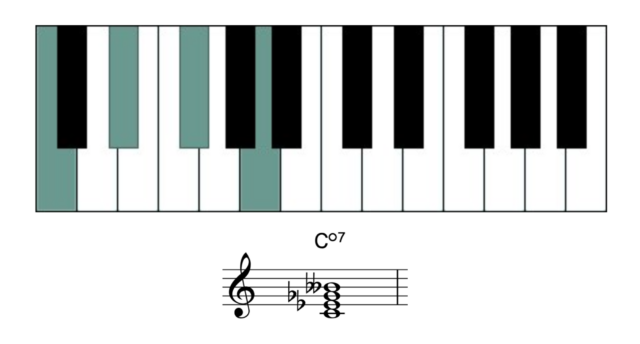
Stacked:
Bbb – minor third
Gb – minor third
Eb – minor third
C – Root
From the root:
Bbb – diminished seventh
Gb – diminished fifth
Eb – minor third
C – Root
The diminished seventh chord is built by stacking minor thirds and can be found on the 7th degree of a harmonic minor scale.
Augmented major 7th chords (maj7#5)
The augmented major seventh chord has a sickly sweet crunchy sound, often used for interesting voice leading in progressions and modulations. It is often used in jazz and romantic period music for voice leading and varied chord sonorities.
The augmented major seventh chord has a bright and tense sound because of the raised (augmented) fifth. This alteration adds tension to the already bright major seventh sound. Try playing this example of a Cmaj7+.
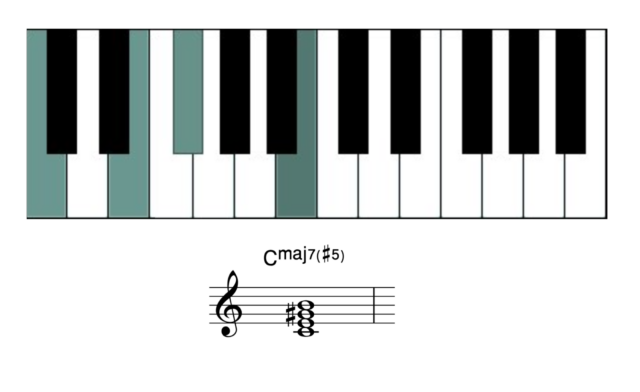
Stacked:
B – minor third
G# – major third
E – major third
C – Root
From the root:
B – major seventh
G# – augmented fifth
E – major third
C – Root
An augmented major seventh chord can be found by stacking thirds from the third degree of a harmonic minor scale.
Augmented dominant 7th chords (7#5)
The augmented seventh chord has a strong and unstable quality, making it useful for adding an extra bit of colour. It is commonly used to create voice leading in progressions and modulation. Like the augmented major 7th it is also often used in jazz and late romantic music and for voice leading, tension and extra movement.
The addition of a raised fifth to a dominant chord adds an extra tension to the chord. Try playing this example of a C7#5.
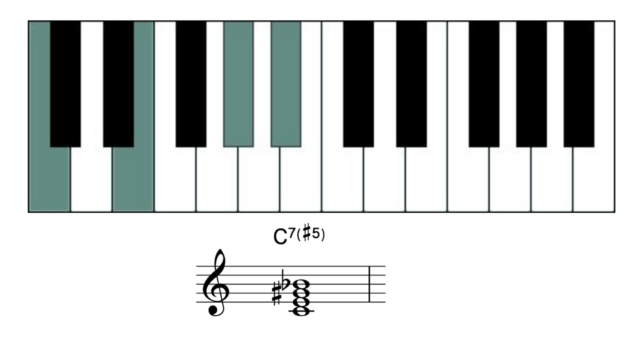
Stacked:
Bb – minor third
G# – major third
E – major third
C – Root
From the root:
Bb – minor seventh
G# – augmented fifth
E – major third
C – Root
This chord can be found in the whole tone scale by playing the first, third, fifth and sixth degrees of the scale.
Altered dominant 7th chord (alt 7)
The altered dominant seventh chord is a unique chord as the piano notes aren’t specific; it can include a variety of raised or lowered chord tones. It is commonly used in jazz and funk for added tension and gives musicians freedom to improvise with more chords and scales.
The altered 7th chord is built by altering one or more notes, such as raising or lowering the fifth, or chord extensions such as a ninth. This can add a strong sense of tension. Try playing this example of a C7alt alternating between the Gb and G#.
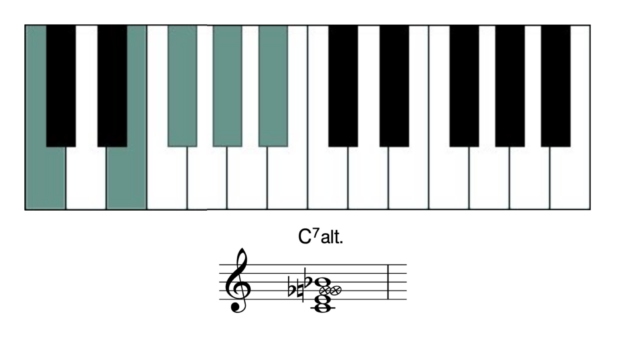
Stacked:
Bb – minor third
G/G# – altered fifth
E – major third
C – Root
From the root:
Bb – minor seventh
G/G# – altered fifth
E – major third
C – Root
As with a standard dominant 7th chord it is formed on the fifth degree of a scale but the variety of alterations that a player is invited to make means it is not tied to one specific key.
Seventh chords downloadable chart
Although that may sound like a lot of information, once you get to grips with these beautiful chords they will become second nature. In the meantime download our helpful chart. Refer to this whenever you get stuck.
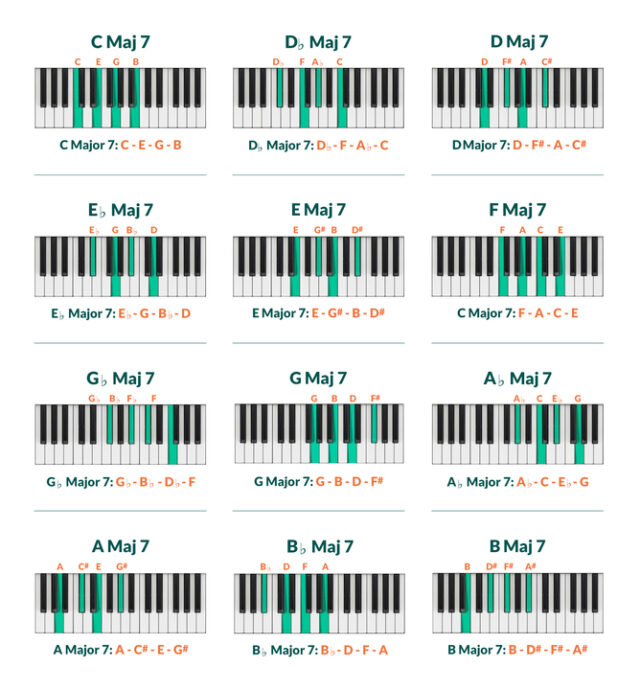
How to play seventh chords with inversions?
Learning chord inversions is a crucial part of understanding how chords and voice leading works. The formula for all four possible inversions of seventh chords are:
- Root position: Root – third – fifth – seventh
- First inversion: Third – fifth – seventh – root
- Second inversion: Fifth – seventh – root – third
- Third inversion: Seventh – root – third – fifth
Some seventh chord inversions work better than others. For example a fully diminished chord works equally well in all inversions. However, chords like the major 7th need to be treated with more care as the first inversion of this chord creates a semitone clash between the root and the seventh. Try out these inversions for yourself and get familiar with how they sound and can help you with voice leading.
Songs with 7th chords
Many well-known songs make great use of seventh chords. With the Skoove app it’s easier than ever to get to grips with them. Take a look at some of our favorites.
Autumn Leaves – Joseph Kosma
This jazz classic is a great way to introduce yourself to seventh chords in a quintessential jazz progression with examples of 7th chord progressions in both major and minor keys.
All The Things You Are – Frank Sinatra
Another jazz standard, “All The Things You Are”, is a great way to get yourself familiar with a wide variety of seventh chords in a range of keys. It’s a great tune to learn once you get familiar with 7th chords in more than one key.
Coppacabanna – Barry Manilow
“Copacabana” is a great way to introduce some seventh chords into your playing. It uses half diminished 7th chords in a groovy manner that elevates this catchy pop song with this extended harmony.
Practicing these songs and any of your favorite tunes with 7th chords on the Skoove app is the best way to improve your playing with live feedback and a great variety of songs. Regular practice with tools like this will improve both your confidence and technique.
Seventh chords where to go from here
Now you’ve got to grips with seventh chords, where do you go from here? These four note chords serve as a foundation for more complex extended jazz chords and more advanced harmonies. Keep practicing, incorporating inversions and experimenting with new progressions to enhance your playing skills. Be sure to use the Skoove app to help when you need it. Happy practicing!
















